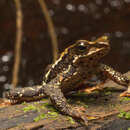pms
nòm ant ël fil


Atelopus laetissimus és una espècie d'amfibi que viu a Colòmbia.
Es troba amenaçada d'extinció per la pèrdua del seu hàbitat natural.
Atelopus laetissimus és una espècie d'amfibi que viu a Colòmbia.
Es troba amenaçada d'extinció per la pèrdua del seu hàbitat natural.
Atelopus laetissimus is a species of toad in the family Bufonidae. It is endemic to Colombia and only known from the area of its type locality in the northwestern part of the Sierra Nevada de Santa Marta, in the Magdalena Department.[1][3][4]
Adult males measure 35 to 39 mm (1.4 to 1.5 in) and adult females, based on just one specimen, 54 mm (2.1 in) in snout–vent length. The snout is acuminate (males) or sub-acuminate (female) in dorsal view. The tympanum is absent. The fingers have traces of basal webbing while the toes are fully (toes I to III) to partially webbed (toes IV and V). Skin is smooth on the front part of the head but otherwise bears granules, tubercles, and warts; these are especially prominent in the tympanic area. Dorsal coloration is olive green, yellowish olive, or ocher with spots. There is a dark brown X-like mark between the eyes and the suprascapular area with spots, and an inverted V-shaped in the back. Ventral coloration is olive, cream or rust with light green, pale lilac or brown spots, specks or vermiculations.[2]
The species' natural habitats are sub-Andean forests at elevations of 1,900–2,880 m (6,230–9,450 ft) above sea level.[1][4] It has been found in both closed-canopy secondary forest and riparian forest. Breeding takes place in streams.[1]
Atelopus laetissimus is only known from three geographically separated locations. The populations appear stable and even locally abundant, but almost all observed animals are males. Habitat loss is a threat, with ongoing conversion of forest to pasture lands acutely threatening one of the populations. The species is also potentially threatened by chytridiomycosis (although as of 2014, the disease has not been detected in Sierra Nevada de Santa Marta). The species is present in the Sierra Nevada de Santa Marta National Park as well as in the adjacent El Dorado Nature Reserve.[1]
Atelopus laetissimus is a species of toad in the family Bufonidae. It is endemic to Colombia and only known from the area of its type locality in the northwestern part of the Sierra Nevada de Santa Marta, in the Magdalena Department.
Atelopus laetissimus es una especie de anfibios de la familia Bufonidae. Es endémica de Colombia. Su hábitat natural incluye montanos secos y ríos. Está amenazada de extinción por la pérdida de su hábitat natural.
Atelopus laetissimus es una especie de anfibios de la familia Bufonidae. Es endémica de Colombia. Su hábitat natural incluye montanos secos y ríos. Está amenazada de extinción por la pérdida de su hábitat natural.
Atelopus laetissimus Atelopus generoko animalia da. Anfibioen barruko Bufonidae familian sailkatuta dago, Anura ordenan.
Atelopus laetissimus est une espèce d'amphibiens de la famille des Bufonidae[1].
Cette espèce est endémique du département de Magdalena en Colombie[1]. Elle se rencontre entre 1 900 et 2 880 m d'altitude dans le nord-ouest de la Sierra Nevada de Santa Marta.
l'amplexus peut durer de 70 à 135 jours chez ce crapaud, le mâle restant accroché sur le dos de la femelle, sans manger, dans l'espoir de s'accoupler[2].
L'espèce est un exemple de taxon Lazare.
Atelopus laetissimus est une espèce d'amphibiens de la famille des Bufonidae.
Atelopus laetissimus is een kikker uit de familie padden (Bufonidae) en het geslacht klompvoetkikkers (Atelopus). De soort werd voor het eerst wetenschappelijk beschreven door Pedro Miguel Ruíz-Carranza, Maria Cristina Ardila-Robayo en Jorge Ignacio Hernández-Camacho in 1994.[2] Omdat de soort pas sinds recentelijk is beschreven wordt de kikker in veel literatuur nog niet vermeld.
Atelopus laetissimus leeft in delen van Zuid-Amerika en komt endemisch voor in Colombia. De kikker is bekend van een hoogte van 1900 tot 2800 meter boven zeeniveau. De soort komt in een relatief klein gebied voor en is hierdoor kwetsbaar. Door de internationale natuurbeschermingsorganisatie IUCN wordt de soort beschouwd als 'kritiek'.[3]
Atelopus laetissimus was voor het laatst gezien in 1992, totdat in 2006 een populatie werd aangetroffen.[4]
Atelopus laetissimus é uma espécie de sapo da família Bufonidae. Ele era endêmico na Colômbia. Seu habitat natural são as florestas úmidas de montanhas, em áreas tropicais e subtropicais, e rios. Está ameaçado pela perda do seu habitat.[3]
Atelopus laetissimus é uma espécie de sapo da família Bufonidae. Ele era endêmico na Colômbia. Seu habitat natural são as florestas úmidas de montanhas, em áreas tropicais e subtropicais, e rios. Está ameaçado pela perda do seu habitat.
Atelopus laetissimus là một loài cóc trong họ Bufonidae. Chúng là loài đặc hữu của Colombia. Các môi trường sống tự nhiên của chúng là các khu rừng vùng núi ẩm nhiệt đới hoặc cận nhiệt đới và sông. Loài này đang bị đe dọa do mất nơi sống.
Phương tiện liên quan tới Atelopus laetissimus tại Wikimedia Commons
Atelopus laetissimus là một loài cóc trong họ Bufonidae. Chúng là loài đặc hữu của Colombia. Các môi trường sống tự nhiên của chúng là các khu rừng vùng núi ẩm nhiệt đới hoặc cận nhiệt đới và sông. Loài này đang bị đe dọa do mất nơi sống.